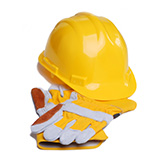March 12, 2021 | Posted by MICRO

If you were to walk onto a construction site 40 years ago, you might have seen workers going about their tasks in hardhats, steel-toed boots, safety glasses, and hearing protection. The buy-in may be better today, but considering you can walk on a construction site today and see more or less the same safety gear, how much has really changed?
Plenty. But the innovation is in the minute details. Each weld, joint, grommet, stitch, hinge, and even the molecular structure of modern PPE is rigorously tested and standardized.
Regulations for construction PPE have been refined on the back of thousands of injuries. We’ve been able to observe what happens in nearly every permutation of positions, materials, equipment, and environment. Now, regulators have determined what to wear and how to wear it while performing hazardous work. Perhaps most importantly, we’ve refined our knowledge of what PPE can protect us from, and what it cannot. The information is available, but it requires that you, the buyer, know what to look for.
The intention of this buyer’s guide is to provide an overview of the classes and categories of PPE used in construction. It will shed some light on the often-confusing labelling and ratings so that you can put the information to practical use when selecting the best workwear for the task, whatever hazards may be encountered.
Click here to download your guide.


